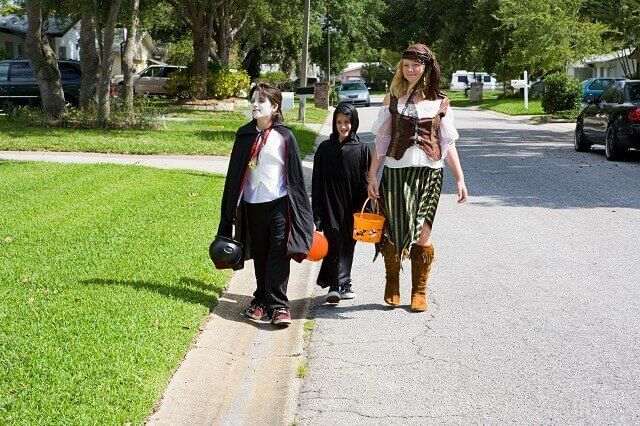Halloween is supposed to be a fun, festive holiday. You want your child to look back on their last Halloween and think of the costume, pumpkin carving, and even the trick-or-treating as a positive experience.
Unfortunately, injuries are all too common for children on Halloween. After all, it is a holiday ripe with potential dangers.
You do not have to lock up your child from the frights outside. Instead, being aware of these common injury hazards can ensure your child has a great Halloween.
5 Reasons Children Are Seen in ERs on Halloween
No one wants to spend his or her Halloween night in an emergency room on Halloween, but it often happens for children of all ages. While some of these injuries are nothing more than a scrape or small cut requiring stitches, others can result in long-term, debilitating injuries that affect your entire family.
Knowing the reasons children go to the emergency room might help you prevent similar accidents from occurring in your family this Halloween.
1. Car Accident Injuries
Car accident injuries are by far one of the more common reasons children go to the emergency room on Halloween night, and there is a substantial increase in car accidents on Halloween, according to the Centers for Disease Control and Prevention. The influx of children out late into the night and the increased number of adults leaving Halloween parties (some intoxicated) create a cauldron full of risks. Motor vehicle versus pedestrian accidents rise on Halloween because drivers do not exercise caution when driving through trick-or-treating neighborhoods.
As a parent, you need to ensure your child is visible to motorists. That includes giving them flashlights while they are out trick-or-treating, adding reflective tape to dark costumes, and even having them wear glow sticks.
Never let your child trick-or-treat alone. It is easy for your child to ignore basic safety, including looking both ways while crossing the street, on a night that condones walking in the street. Go trick-or-treating with them and discuss street safety before you head out for the night. Ensure everyone is on the same page for how they cross the street and keeping an eye out for cars that might not look out for them.
2. Home Injuries
Homes should be safe for trick-or-treaters, but not all homeowners are proactive in creating a safe environment for visitors on Halloween night.
Do your part by clearing your driveway and walkway of any potential tripping hazards, including toys, garden tools, hoses, lawn décor, and bikes. Keep your Halloween decorations off walkways. And if your decorations use power cords for electricity, do not have those cords cross over sidewalks and the porch where children will walk.
Teach your child to look out for tripping hazards while they are going to neighbors’ houses. Also, make sure they wear appropriate shoes and that their costumes are not long enough to tangle and cause them to trip, because the CPSC sites ill-fitting costumes as a common cause for falls on Halloween.
3. Candy Injuries
While rare, there are still instances where candy handed out for Halloween has been tampered with. You can avoid these injuries by:
- Only allowing your child to trick-or-treat from your neighborhood and not venturing into neighborhoods they do not know.
- Inspecting your child’s wares for the night before they are allowed to eat them.
- Discarding any candy that is questionable or looks as though it was altered.
Also, limit how much candy your child eats for the night. While it is a late night full of sweets and treats, children are also seen in the ER for stomach upsets after overeating candy.
4. Burn Injuries
With the various types of LED candles out there today, there is no reason to use a live flame candle in your carved pumpkins or Halloween décor. Still, some homeowners choose to adorn their porches with real candles, which increase the risk for fire or severe burns. According to Annette Matherly from the University of Utah Burn Center, burn injuries are still a common concern for parents on Halloween night – even with a fireproof costume. Furthermore, since 1980 there has been at least 16 cases of children being in an accident and suffering burns because of their costumes, and one death.
Make sure your child’s costume does not have a long cape, sleeve, or wig that might ignite when passing by these flames. Also, teach them to be cautious when live flames are present and to not play around candles.
5. Product Injuries
Halloween is a time of the year where everyone breaks out their seasonal decorations, children use props for costumes, and the risk of injury from a defective or unsafe product rises.
Manufacturers are supposed to create safe products. But during Halloween, unsafe items flood the market all the time and injuries are not reported until after the season.
Avoid any props for your child’s costume that are sharp-edged, because these tend to cause eye injuries on Halloween. Also, make sure the products you use for your Halloween display are safe for the new season. That includes inspecting all props and décor before installing them and discarding any electrical items that appear worn or have frayed wires.
What Can You Do If Your Child Is Injured on Halloween?
Injuries can happen on Halloween even when you are the most overly cautious parent. You cannot control everything your child does or the actions of those around them.
When your child suffers injuries on Halloween because of someone’s negligence, you may be able to hold that person accountable for their actions.
Injuries on Halloween that result in long-term consequences should not be a financial burden for your family. Instead, you can seek compensation from the at-fault party to cover expenses, including medical costs, lost wages, future medical care, pain, and suffering.
To explore your options, meet with an attorney from Brett McCandlis Brown & Conner, PLLC. You can schedule a free, no-obligation consultation with our attorneys today at 206-488-1462 or request an appointment online.


